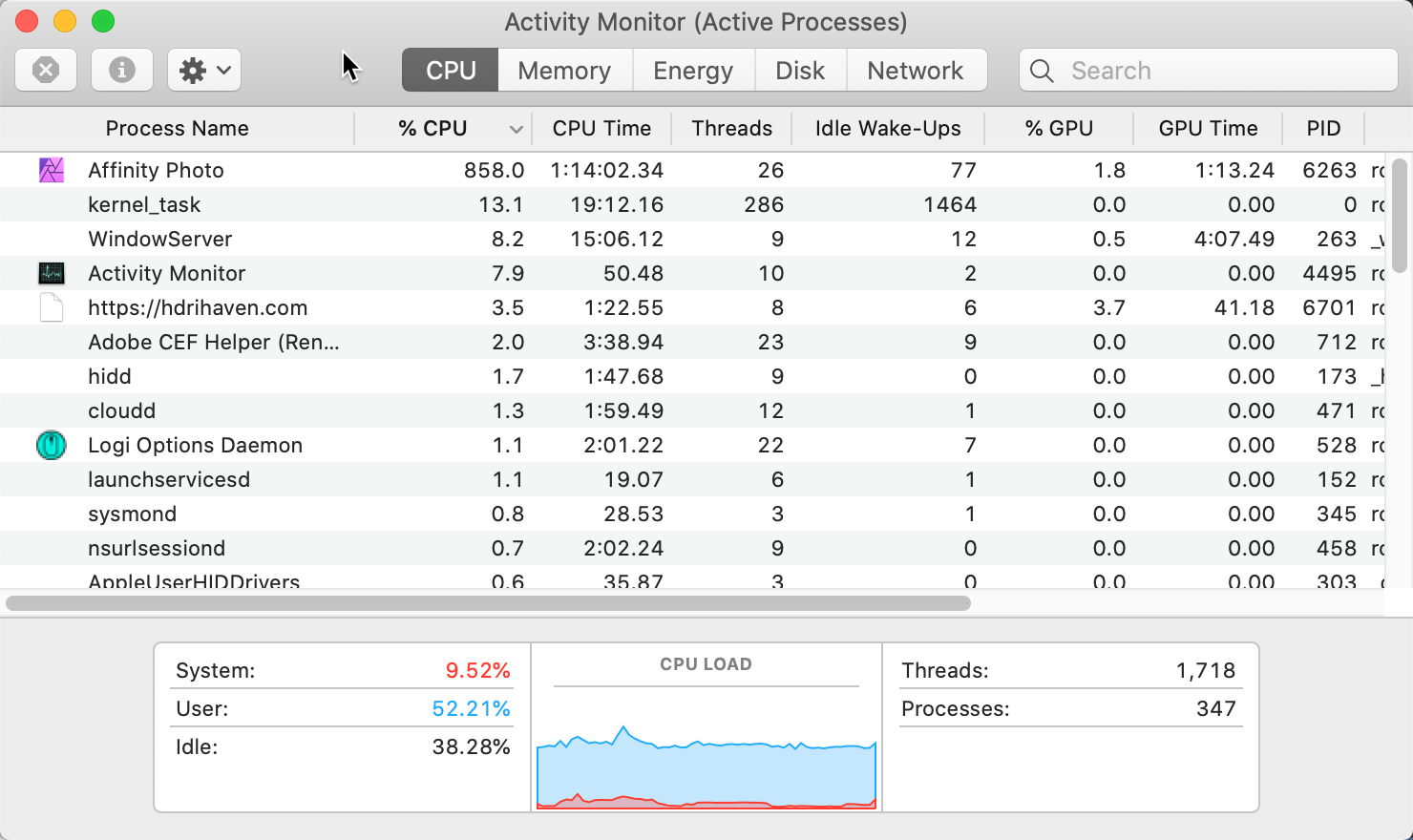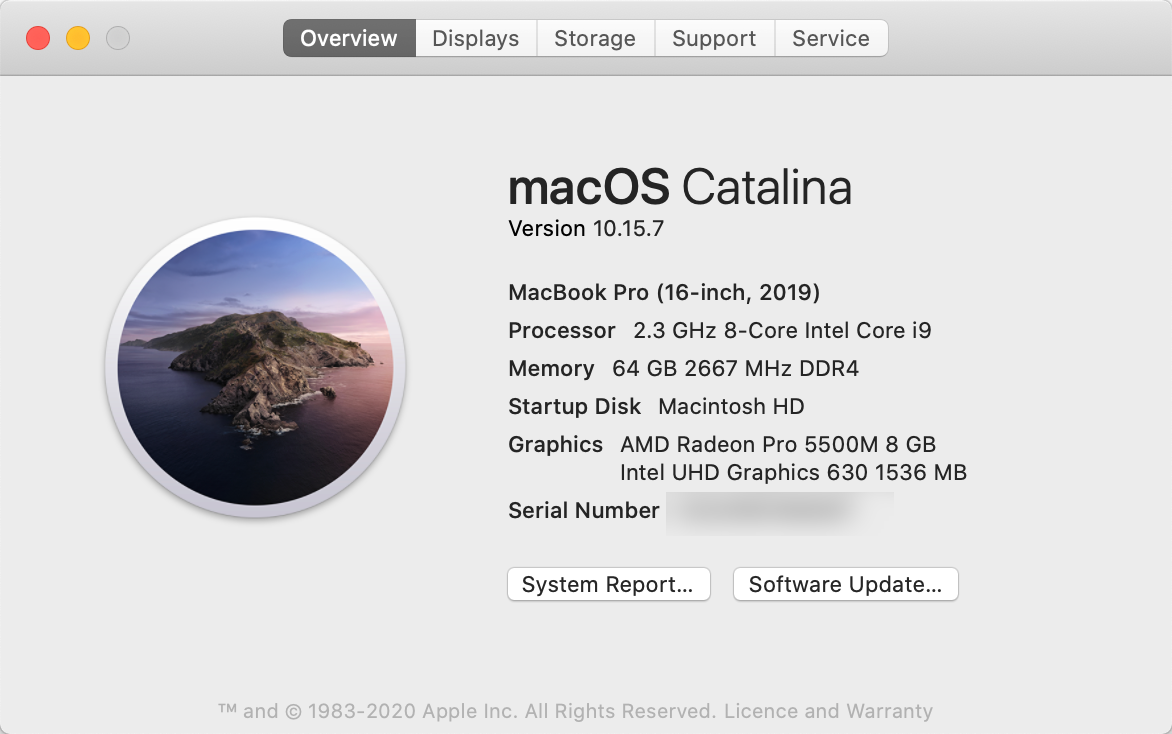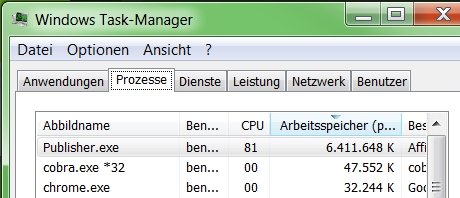Search the Community
Showing results for tags 'Performance'.
-
Hi there, I noticed an overall drop of performance with the newest version. Especially when liquify masks are involved (but not necessarily bound to the use of liquify masks). It will often react with huge lags even with only using the GUI (selecting tools, opening menus, switching personas etc but not doing anything to the file itself). Can someone else confirm? Update: Its not only sluggish but also a first grade battery consumer. 30% in half an hour. My device is an iPad Pro 2nd Gen 10.5" with the latest OS installed (14.4 as today).
- 7 replies
-
- ipad
- affinity photo
-
(and 3 more)
Tagged with:
-
Hello all, Apologies if I am posting this in the section For some my GPU spikes up to 93-100% usage when I use select all (ctrl+A) within a document even if it is a fresh document with nothing in it (screenshot attached). Affinity Photo Version: 1.8.5.703 PC Specs: Display: Dell U2713H (2560x1440) GPU: 8GB Nvidia RTX 2060 Super CPU: Intel i5-10600K Is there any way to fix this? Any and all help is much appreciated
- 3 replies
-
- affinity photo
- gpu
-
(and 1 more)
Tagged with:
-
Sky replacement of a 360º spheric panorama, 27294 x 13647, jpg exported by PTGui Pro. Sky from HDRIheaven, 16k, 32 bit/HDR, opended separately, tweaked in Develop Persona, layer copy & pasted to jpg already opened file. Compositing itself is RGBA/8 bit Adobe RGB (1998). That corresponds to the LCD of MBP16. Step - by - step: Select: Layer / Live Projection / Equirectanguar Projection Turn to seam (congruent to sun) Zoom out as far as possible. Create new layer. Fix seam with Healing Brush Tool, «Layer and below» selected Using healing brush end up in infinite waiting times. Healing on separate layers, tool set to Current Layer & Below. Brush size is 1482. 100% opacity, 100% flow, hardness 25%. The saved .afphoto is only 1.54 GB, I have other files up to 8 GB but not that dimensions, more normal ones like 6000x4000 or ± 8000x6000 and I do not face that issue. This has been only 1 stroke with the healing brush, waiting about 10 minutes to be able to save for the first time: Saving & Closing Affinity Photo ended in: The Mac is quite beefy: I can send you the files for analysis but I assume that exceeds the upload space available in the forum. You may send me of course an sFTP access or so. Cheers, Roland
-
It's what the topic title says, the further you zoom in, the slower the brushes becomes. If you're zoomed way out brushes perform between well to acceptable, depending on their complexity. As you keep zooming in, the performance drops further and further until they're unusable. This is true even for basic round brushes, but it's more noticeable in complex brushes, such as Frankentoon's. I've also noticed it's worse if you're drawing over vector shapes, which is the whole point of these brushes. See the video for a visual reference. iPad Pro 9.7" with latest version of iOS 12.4 and Affinity Designer 1.7.1. I've tested and this also happens on Windows, the more you zoom the worse the brushes perform. But on Windows, especially on a desktop machine, the sheer processor power masks the issue. Thanks! RPReplay_Final1565346075.mp4
- 6 replies
-
- pixel brush
- brush
- (and 8 more)
-
Hi, I want to purchase Affinity Photo on my 7th generation iPad (2019) or in my macbook air 2020 (i3 10th generation processor 1,1 GHz with turbo boost up to 3,2 GHz, 8GB RAM). Which one would work better? (In terms of performance) And just to be sure, both the ipad and the mac version are a one time purchase without any subscription? Thanks in advance Alexander Geisse
- 5 replies
-
- affinity photo
- performance
-
(and 2 more)
Tagged with:
-
I am currently layouting a photo book (330x240mm) with 500-600 pages in Affinity Publisher on my Mac. Unfortunately, the memory consumption of Publisher is huge. I set the memory limit in Publisher to 28 GB (out of 32 GB I have in total) and disk warning to 64 GB. I have 500GB free space on my SSD and Publisher takes about 351GB while saving the document. Sometimes while moving pictures it crashes (but luckily keeps a backup file) and saving the file takes ages. The pictures are all linked and do have less than 10GB in total in full resolution. Is this a common behavior or is there anything I can do to fix this. Really looks like kind of a memory leak and is not fun working at all. Maybe you do also have some performance recommendations for my 15inch 2018 MacBook Pro with Radeon Pro 560X 4 GB, 2,9 GHz 6-core i9, 36 GB RAM and 1TB SSD? Thank you so much in advance! I really would love to do this project with Publisher and not go back to InDesign.
- 6 replies
-
- affinity publisher
- performance
-
(and 2 more)
Tagged with:
-
Hi! Thanks to the developer for their contribution. Merry Christmas! In most cases, the performance of affinity photo is excellent. But I noticed that in some cases it is slow I used a 100 million pixels Lab/16 canvas to create twenty layers. The save of large-area modifications is extremely slow or even horrible. This is not a bug or a computer problem. Large-size (1000+) brushes are slow. Because of the lack of hardware acceleration At the same time I use the macos version, the speed after 1.7 is amazing, the filter responds in time without any lag, and everything is attributed to metal acceleration (in macos 1.7 metal) Please consider adding Lab/8 support to provide a faster preview than lab/16, especially in the current missing gpu acceleration. I will continue to use affinity photos in macos mojave (metal2 api)
-
Hello team, is the ARM technology of the new macs an improvement in the Affinity suite? what are the advantages of this change?
- 21 replies
-
Hi, I do a lot of photo editing in Affinity Photo and Capture One. I also do a lot of vector editing in Affinity Designer. Last year, to speed up workflow, I bought a new Apple iMac Pro 3 GHz 10-Core Intel Xeon W, 64GB memory, Radeon Pro Vega 64X 16 GB graphics card and 2 TB SSD. This machine did cost me 8500€! This is very very expensive for me, but previously I had a MacBook Pro (2016) that was too slow for my graphics editing. So I thought to me let's spend a little more money to get a really powerful and fast machine, so my graphics editing will be in realtime without waiting time at all. At least that was what I wished and thought. But I have to say that neither Affinity Photo nor Affinity Designer have become much faster with the new computer. Both programs often have very long waiting times when working. I always watch the CPU usage and see that no core is ever used to its maximum. Let alone that all cores are used. It is absolutely incomprehensible to me that I have waiting times in the programs if there are enough performance resources available but they are not being used. For example, I like to work with the Inpainting Brush in Affinity Photo. Sometimes I really have to wait about a minute for it to finish calculating. It is very annoying. During this time, my computer has enough resources that Affinity does not use to calculate it faster. It may take advantage of 2-3 cores in half and the GPU by a quarter. But the rest of the cores do almost nothing. And we're not talking about huge photos here. I recently edited a 12MP iPhone photo. Or I work in Affinity Designer with graphics that consist of approx. 2000 elements. It is almost impossible to select all of these elements and move them around. It is so jerky that the graphics are rendered here and there and lag behind. It is impossible to work with. Here too it can be observed that perhaps two of the CPU cores do something, but are also underutilized. The rest does nothing. The GPU doesn't do anything either. Believe me, I've tried every combination of performance settings in Affinity Photo and Designer. Because it really annoys me that everything is so slow! But it only got slower than faster. I would understand that there is a waiting period if all resources are used to the maximum and there are no resources left. But because the CPU and GPU of my machine are mostly idle while I see slow process bars and long waiting and reaction times, I wonder if something is wrong? My question is, can I do something about it e.g. use certain special settings or is Affinity Photo and Designer not developed for using the performance of my machine? I've already spoken to Apple Support who checked my machine. But everything is normal and fine. I have reinstalled macOS and every app. But it hasn't changed. I mean a year ago this machine was advertised as "Power for Pros" or as "the fastest Mac every build". It would only have been faster with the 18 cores version with 256GB memory. So I ask myself, what machine do I need to buy from Apple to have a noticeable speed advantage? Best regards, Christoph
- 43 replies
-
- performance mac
- performance
-
(and 6 more)
Tagged with:
-
When loading generative artwork - Affinity Designer slows down to unbearable levels even with relatively easy meshes This problem seems to exist on all platforms affinity runs on - which leads me to believe basic acceleration structures are not in place. Example file: https://tilings.math.uni-bielefeld.de/img/substitution/danzers-7-fold/patch.pdf Import this, try select all/ungroup/do anything to it -> framerate down to 1fps even on the beefiest of workstations Same issue can be recreated by creating any shape and copying it about 100 times.
- 1 reply
-
- affinity designer
- performance
-
(and 1 more)
Tagged with:
-
Hej there, I am using an i7 Skylake with an GTX950M and 16GB RAM, still I get very very slow panorama and HDR renderings from Canon CR2 files. At the same time, very little CPU capacity is used (~15-20 %). Tonemapping panoramas takes easily a complete afternoon! I would love to see an performance upgrade in future versions (even if I have to pay for it). Otherwise, Affinity Photo is close to irreplacable as the generated images are excellent. Even the output using the default settings is much better than for example Aurora HDR, imho. Sincerely, Benedikt
- 2 replies
-
- performance
- affinity photo
-
(and 4 more)
Tagged with:
-
I work on a illustration with a huge number of small dot that i start on Illustrator and i work fine ; but when i change to Affinity, everytime i duplicate an element (and i do that a lot) my computer freeze for a few second. I loose a lot a time. Then i notice that the time my computer freeze was the same for one or multiple duplicate elements. And when i move a element, my PC doesn't freeze. So all i have to do was duplicate a lot of element and move them where i want.It's save me a lot of time. Hope that can help someone in the same situation (and sorry for my bad english).
-
Hi, I have a iMac Pro 2017 with 3 GHz 10-Core Intel Xeon W, 64 GB 2666 MHz DDR4, 2 TB SSD and Radeon Pro Vega 64X 16 GB graphic card. I use Capture One to develop my 61MP Sony A7rIV photos. Some of the photos need to be edited in Affinity Photo and I use a TIFF 8bit uncompressed AdobeRGB as format. The image has 9504x6336px size. Saving the picture after edit in Affinity Photo takes a lot of time. It takes ~14 seconds for every photo!!! Is that normal for such a high performance machine? The Activity View does not show any heavy consumption of resources while saving in that 14 seconds. Greetings, Christoph
-

Panning & Zooming laggy when switching windows
AvesNoctis posted a topic in V1 Bugs found on Windows
First of all: Love the new features, especially the isometric grid, cant wait to use them seriously! Usually i work on my laptop and have an open browser to google stuff. I noticed that the panning/zooming drops in performance significantly when i switch back to my Affinity Designer Window (artboard). After restarting Designer it works ok for a while, but it always comes down to opening a browser window, switching back to Designer, zoom in/out - no animation or it does not zoom properly. If i want to pan - then i would need to use the navigation bar even though Space + drag is so convenient when using a tablet. In the past it was a non-issue, so i really don't know if it's my hardware. I used to do Vector/Pixel-based Artwork and Designer handled everything fluently. I panned and zoomed like crazy Now i struggle with simple Logo-Designs Could it be that Designer has become a bit resource-hungry since the update? Or is it me? Can i do something about it? My laptops' specs: i7-6700HQ 2.6GHz 16GB RAM Intel HD Graphics 530 NVIDIA GeForce GTX 960M (i switch them up sometimes) Wacom drivers are up to date (intuos pro) -
With more complex Publisher documents, I sometimes experience crashes just moving about in the document.. I have a feeling that the crashes are related to settings in the Performance section of the Preferences, but I can't find anywhere a FAQ or a comprehensive discussion on what the different choices really mean for the stability and performance of the app. A few questions: In the Display section, which is more stable: Metal, OpenGL, OpenGL (Basic) or Software rendering? I suppose Metal is fastest, or am I wrong? Does clicking "Use only integrated GPU" affect anything, especially as I only have an integrated GPU in my Mac Mini. What Does "integrated" refer to: Intel integrated graphics on the chip, or Integrated, as in "internal" as opposed to an eGPU? What effect has lowering or enlarging the RAM usage limit? Is 6 GB enough for more complex documents? Is it a good idea pushing the limit way over installed physical RAM size (I have 16 GB physical RAM installed)? Shouldn't apps allocate memory dynamically, anyway? Why am supposed to fiddle around with this? Does View quality affect the stablity of the app, since one would assume better quality would be more taxing on many resources? Does hardware acceleration/Metal compute really work in any meaningful way on Intel integrated graphics, with its paltry 1,5 GB RAM, which it allocates from main memory? So many questions, I know.
- 6 replies
-
- memory
- performance
-
(and 1 more)
Tagged with:
-
As I've mentioned in this post, Affinity Designer's brush performance isn't all that great, but what's surprising me is that I've found out the issue is not present in Affinity Photo at all! I've recently purchased Affinity Photo while it was on sale, and immediately the brush performance seemed better, but I've tested it and it's a very significant difference! For this I've created an identical document on both Designer and Photo: 2800 x 2800 pixels @ 300DPI CMYK colour space using the same brush on both apps using the same colour, just in case same zoom level only one pixel layer same iPad Pro 9.7" (2016) obviously both apps running simultaneously If you look at the attached video then no further explanation is needed, the brush paints smoothly and fast on Photo, while on Designer it's rendered slower and in blocks of pixels, as if it's struggling to keep up. I think that covers it, but let me know if you need or want more information. Thanks! RPReplay_Final1573724065.mp4
- 3 replies
-
- brush
- performance
-
(and 4 more)
Tagged with:
-
The attached Affinity Designer project illustrates how different drawing techniques can result in pdf export files that differ is size substantially. I discovered this while developing images that are to used in an iOS app. Of course, we can expect the size of the pdf file to impact the performance of the app. The attached AD project has three artboards. Each artboard has a separate drawing of a flower - all of which look much the same: Yellow-Flower: The pdf for web file size is 282 KB. Each of the twelve petals is a separate curve object with yellow fill and a black stroke. The inner pistils is comprised of 27 brown ellipses imbedded inside a single black eclipse. Red-Flower: The pdf for web file size is 31 KB. The twelve petals is comprised four curve objects (each represent three leaves) with red fill and black stroke . The inner pistils is comprised of 27 brown ellipses imbedded inside a single black eclipse. (Same as yellow flower.) Blue-Flower: The pdf for web file size is 176 KB. The twelve petals is comprised four curve objects (each represent three leaves) with blue fill and black stroke (same as red flower). The inner pistils is comprised of a single black curve imbedded inside a single brown ellipse. Why are these file sizes so different? The yellow flower has only nine additional petal curve objects compared to the red flower. Yet, the pdf file size is also nine times the size. Note, the the pistils are the same. The blue flower uses the same petals as the red flower. However the pistils were refactored into only two objects, one complex curve and one ellipse. The complex object was created by subtracting the 27 ellipses from a single ellipse. The result of this distillation of the pistils causes the pdf file size to grow from 32 KB to 180 KB. is there a knowledge-based article that will help me understand why this occurs and how to avoid these problems during design? Flower-Yellow.pdf Flower-Blue.pdf Flower-Red.pdf Flowers.afdesign
- 20 replies
-
- performance
-
(and 2 more)
Tagged with:
-
Hello The problem: I have have had Affinity Designer for 1 year now i think, but had not used it for a while. Came back to 1.7.1 version and the program felt a bit slow. I did update to 1.7.2 and still have this issue, With slow i mean, every time i used the view tool, the screen felt like, it was moving with a 0.1sec delay (huge smoothign effect) same goes for selection tool when selecting an area or simply moving objects, Bigger files around 50-60 MB are even worse sadly. What i tried: I tried looking into the performance settings and found the cause, which is the Nvidia GPU render option. I use laptop so i tried integrated card: Intel HD 630 and it started working pretty smooth, but has weird lag spikes from time to time. What may be the cause for the software to slower down on Nvidia GPU? First i thought i may have throttling issues, but i have undervolted my CPU and the laptop never reaches more than 42* temp. My laptop specs: Dell XPS 15 9570 CPU: Intel i7 - 7850h GPU: Nvidia GTX 1050 TI - Max Q edition Ram: 32Gb In short, the Intel Graphics work better which should not be like that and any help is appriciated
-
Doing a series of technical drawings – not complicated. Copying a few lines with arrowheads (or even just 1) into a document created in a pre-arrowhead Designer version, results in the spinning beachball of death. Is there a workaround with older documents to avoid this issue? (I have tried some of the old favourites – like saving as without success). Cheers Friatec Tee T EF Blu-ill.afdesign
-
Affinity Designer 1.7.2 (and 1.7.1) is lagging and/or crashing/not responding when I'm scaling/moving/rotating a complex vector image which is placed in a masked layer. If the object is placed as a normal layer I can scale/move/rotate it without a hitch. it can be reproduced (at least on my laptop). Tried the same thing with version 1.6.5 - had no problems. - Working with Version 1.7.2; - Windows 10; - 16 GB RAM; - Intel i7-6600U CPU @ 2.60GHz 2.81 GHz
- 9 replies
-
- performance
- crash
-
(and 1 more)
Tagged with:
-
I'm the first to admit, I'm a total Affinity fanboy so this is a difficult one --- I've been sitting on this problem for a week or so as I know publisher is a massive deal and a major focus for the Affinity team - but I can't work normally on my children's book illustrations as there appears to be slowdowns, the most annoying being the time it takes to open the .afdesign file which has gone from around 4 minutes to open in 1.6 (which ran nice and quick and snappy) and roughly about the same time to open in betas 1.7.0 - 1.7.0.7 (still nice and quick performance) then with the move upto beta 1.7.0.8 performance had slowed to a crawl then 1.7.0.10 refused to open the file but appeared to be fixed in beta 1.7.0.11 although it was now taking around 10 minutes to open and still with the slow performance issues (originally reported on May 6th - see below) With the 1.7.0 Appstore release I was having slightly better performance and far less beach balling but I timed the document opening at 16 minutes (WHAT!) then came the 1.7.1 update (me hopeful I'd get some performance increase) but I was left watching "Loading 1 document" for ages way more than 16 minutes before force quitting and restarting my mac (wish there was a progress bar?) so thought I'd time it opening = 46 minutes (AAAGGGHHH!) well at least it opens! - I though before bothering the forum, I'd have a go at trying to improve things with a few tricks that helped me out years ago in Illustrator and also Quark - so I went back to the first 8 pages which I put together in 1.6 which opened up in around 30 seconds in 1.7.1 and was super quick and nippy to get around then I took pages from the 1.7.1 46 minute doc and copy pasted into fresh art boards in the 8 page doc - all went really well I I was getting nippy performance compared to the 46 minute version, which was slow and choppy to get around - re-saved as 'NITN proper.afdesign' I also went through all the pages and layers and trashed anything not in use, in order to streamline the file - saved, quit Designer and re-started and re-opened the new file, thinking I'd wait maybe 5 minutes or so so at most, thought I'd time it, just in case = 1 hour 50 minutes (WTF......AAAAAAAAAAGGGGVHHHHHHHH!) + lots of beach balling - although, no more jumpy, choppy performance when getting around and zooming (between beach balls that can lock up for around 5 minutes) The artwork for the first book in the series (which uses all the same characters, textures and all that and is the same 26 page format) was having similar performance and opening issues in the last beta but now takes less than a minute to open and is nice and fast and fluent in 1.7.1 and all my smaller documents run like a dream. I'm currently at the final 'last tweaks stage' before we get PDF and hard proof copies to send out to agents and publishers along with the first book (we are down to the last 30 hard proof copies) - all flawlessly put together in publisher using rasterised linked tiffs of the art boards from the problem file. Just wondered if someone can offer help or advice - and yes, after tuning into Affinity Live the other night, I wish I had Metal compute but I need to stick with El Capitan as it's the last Mac OS that runs 32bit apps (CS5) without major issue (I only very occasionally run Illustrator to plug the gaps til' designer has all the knobs and whistles) but the main one is Acrobat pro 9 which I need for checking pdfs as theres nothing else, apart from Callas PDFtoolbox (£500!) so NO METAL (for the foreseeable future) (original forum bug report:-)
-
I've created a DIN A4 booklet about 80 pages. Before the last two updates the app works good and fast. Now when I open my file, the memory and CPU explode and the app or the whole computer works really slow. After a few minutes the CPU works normaly but the Memory is still high used. Sometimes the tool crashes when loading the file. Is that a known problem? Any Tips for a short-term solution?
- 5 replies
-
- performance
- crash
-
(and 1 more)
Tagged with:
-
Under Preferences -> Performance are the two checkboxes Dither gradients and Use precise clipping. Using the help section won't help me: Dither gradients speed up the performance? So why should I leave it unchecked? Choose a clipping option implies that there is more than just a checkbox. Checked or unchecked what is the difference?
-
- 1.7..1.404
- preferences
-
(and 1 more)
Tagged with:
-
Hello! I have had a few issues recently that seems to be performance related (serious lag and erratic behaviour of node tool and move tool) I have attached a video of a work session (sorry if it's long and tedious, it's a realistic snippet of how I, and probably many others, have to work) I don't know how to put subtitles on a video so I will put a list below with the issues I found. Now, I must say, as it have been pointed out multiple times a smooth and/or simplify option on path and nodes would be greatly appreciated. I know that I will receive comments on the fact that I should learn to be proficient with a pen tool before trying to smooth paths, because that what I have been reading a lot on these forum. I get that most people who answer here are "creators", but I suspect a lot of us Designer users are what we call "artworkers". Meaning we have to work on files given to us by others (who don't care if their files make sense or not - they don't give a crap, they couldn't be bothered, don't even try to talk to them ) The case I am presenting here is a 146 kb .eps file provided by the studio in charge of digitizing the assets from Schultz estate. They provide those files (take it or leave it) to those who buy the licensing rights. My work here is to smooth out the jagged lines, because the scan was probably done, digitized via livetrace (and converted to .eps) from a small/damaged/blurry line drawing. So if you have the patience to go through the video, you'll see that the file has 81 layers (which I tried to organise a bit prior to recording the video). You'll see that I really lack the availability to use a smooth tool or a simplify option. I tried to use the "smooth" function in the contextual menu, but it makes little difference to the end result. so the list of issues with the timecode are below: 0.06: trying to use the space key to pan the canvas, it's either slow or simply not working (it sometimes does) have to use the navigator instead 0.14: Same with using the zoom (Space bar + CTRL) 0.38: Trying to select a shape with the node tool (it sometimes works) end up using the layer panel (wading through 81 layers) 1.24: The node tool now has a mind of its own. At the particular moment I am not even touching the tablet with the pen. I am just hovering over the drawing after clicking the node and the node tool has now picked up the node and travels with it. I get the same behaviour with a mouse. (but who would use a mouse?). Again, I am not clicking, nor click/draging the node. I have to do a number of CTRL+Z to restore state. 3.10: Happens again. As I said, the original file is 810 KB. It's 146 kb when saved as an afdesigner file. Beyond the lag/performance issue, I would like to plea for artworkers workflow to be taken into account in the development of the software. When I do an inventory of all the features I'd like to add (select similar for example) I can see that these are features aimed at modifying shapes and paths as opposite as creating new ones. It seems to me that the project managers had "creators" in mind and not artworkers (simplifying here), meaning that if you are working on a generic .eps or .ai file created by someone else, it's infinitely easier do it in Adobe Illustrator (because those feautres exist in .ai), whereas I have no trouble using all the - very well - thought-out tools of Affinity designer if I want to create a design from scratch (I am someone who is naturally very neat with her layer stack, and I always name and group my layers, it's even a breeze if someone has to work on my files ). But if you decide that your software isn't aimed primarily at artworkers, then I think you're losing out (particularly given the price and licencing model, artworkers are AD natural customers. Apologies for the Sundays ramblings.... Hope everything makes sense... record_000001.avi
- 4 replies
-
- performance
- simplify
-
(and 4 more)
Tagged with:
-
Input please: As a photographer I’ve been using Lightroom on my (now outdated) iPad for years, and used my wife’s Macbook Pro when I needed features, not available on my iPad (photoshop). I don’t really like Lightroom, I’m intrigued by Affinity Photo, and I need new hardware - so here’s my dilemma: Is there any difference in performance/possibilities/features/flexibility using Affinity Photo on an iPad Pro, or an iMac? Because that might decide my hardware choice (I really like my iPad cuz I travel a LOT, but the output and flexibility is far more important). I hope this makes sense! Thanks in advance for any help!
- 22 replies

















